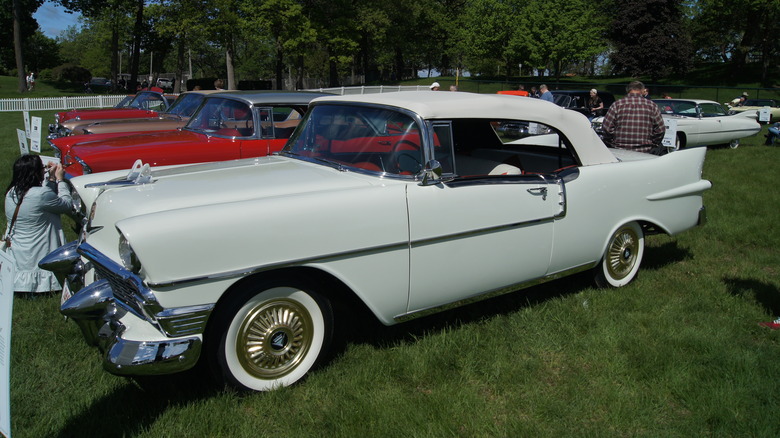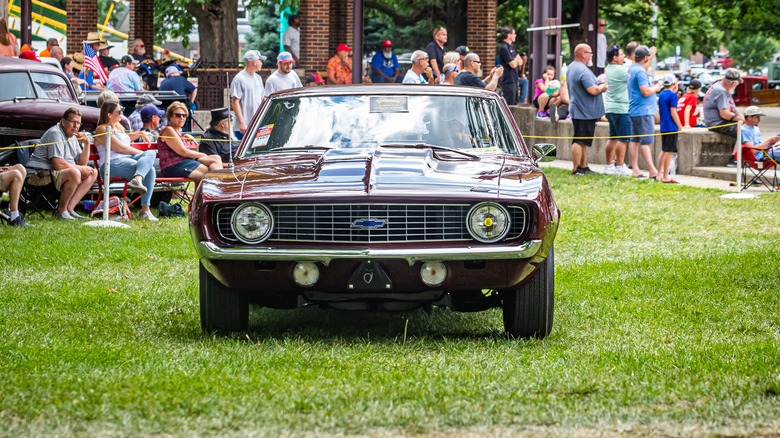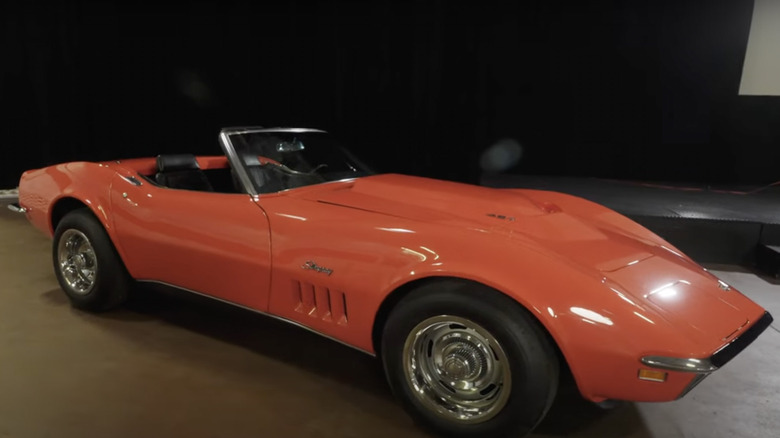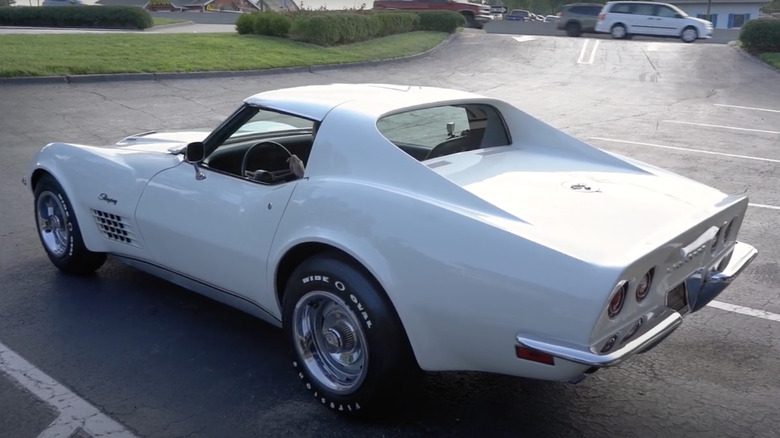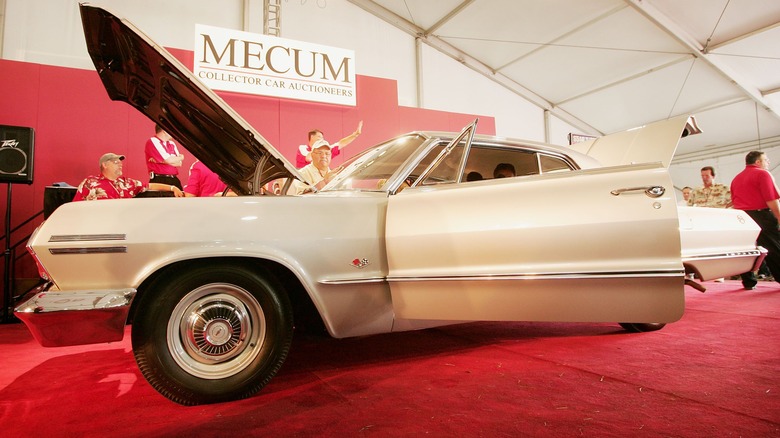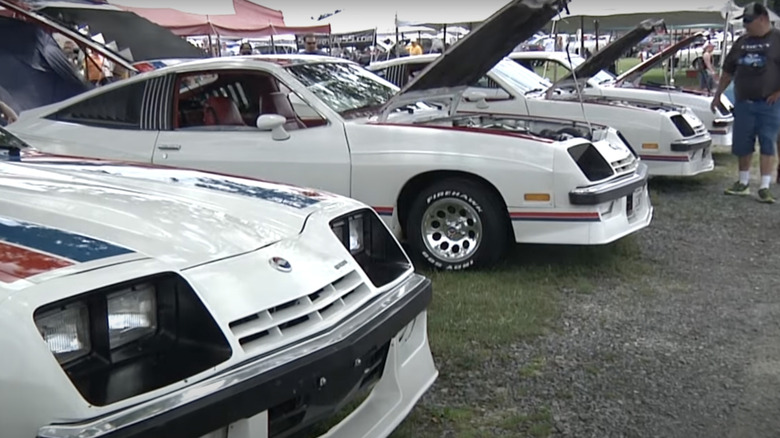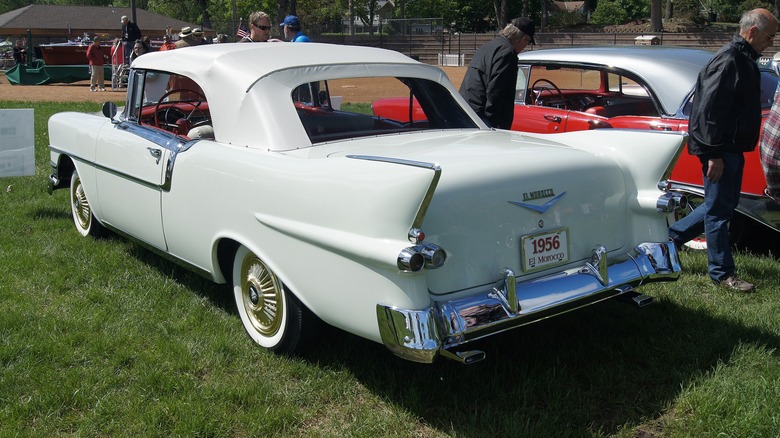6 Of The Rarest Classic Chevys Every Car Collector Wants
When General Motors founder William Durant teamed up with Swiss race driver Louis Chevrolet to form a new car company in 1911, they borrowed Chevrolet's name for their venture. Their first car, the 1912 Classic Six, cost $2,150, which equates to almost $70,000 today. Since then, Chevy has produced more than 200 million cars, trucks, and SUVs. The Suburban jump-started the SUV era in 1935 and has been in production through 12 generations and 89 years, making it the longest continuously sold nameplate in automotive history. The Corvette came along in 1953 and is now in its eighth generation.
As the muscle car era flourished, Chevy followed the 'Vette up with beasts like the Camaro, Chevelle, and Nova. Although overall production numbers for Chevrolet products are large, there are some years and models that saw limited runs and are highly prized by collectors. Here are six Chevys that deserve a place in the most exclusive of garages.
[Featured image by Greg Gjerdingen via Wikimedia Commons|Cropped and scaled|CC-By 2.0]
1969 COPO Camaro ZL1
Chevy introduced the Camaro in 1967 as an answer to the Ford Mustang, which had sold more than 1.5 million units since its 1964 debut. Chevy made a high-performance Z/28 version of the Camaro beginning in that first year, but in 1969, Illinois Chevy dealer Fred Gibb took that concept one step further. Gibb and St. Louis race tuner Dick Harrell developed the Chevy Central Office Production Order (COPO) 9560 package for the 1969 Camaro that featured an aluminum block, 427 cubic inch V8 tagged the ZL-1. Gibb ordered 50 of the 9560 Camaros, and Chevy made a total of 69.
Gibb was only able to sell 13 of his, and Chevy bought back the remaining 37, sending them to other dealers. There was also a 9561 COPO package that used an iron-block 427, but more than 1,000 were made with this option. The ZL-1 Camaro's rarity and 5.2-second zero to 60 time make it a hot commodity 55 years after its release. Only six have changed hands in the last five years, and the average sale price was $674,000.
1969 Corvette Stingray ZL-1
The 1969 Camaro wasn't the only Chevy to get the aluminum-block 427. In the middle of the year, dealers began offering the ZL-1 in the Corvette as well. To get the aluminum-block V8, Corvette buyers also had to add an upgraded ignition system, brakes, and suspension, plus a limited-slip rear differential. These options bumped the cost of a ZL-1 Corvette up to a whopping $10,048.15. Accounting for inflation, that equals about $88,000 today. For that investment, ZL-1 Corvette buyers got the above chassis enhancements, but no radio or air conditioning. The radio would have been useless and A/C unnecessary, though, with the screaming 560 horsepower engine and 12.1-second 1/4 mile time. It's almost impossible to find a model more exclusive than the ZL-1 Corvette; Chevy only made two.
The ZL-1 'Vette was planned as a homologation qualifier for the NHRA and FIA, but those racing dreams were never realized. The Monaco Orange specimen shown above is the only convertible ZL-1 ever made, and was purchased by Pennsylvanian John Maher in December of 1968. Maher had to call in favors from two friends, elite Chevy dealer Don Yenko and SCCA champion Grady Davis, to get his order through. When Maher's initial order was rejected, he was encouraged to enlist Davis' help, and the legendary driver wrote a letter on his behalf. Maher held on to the car until last year when he sold it through Sotheby's for more than $3 million.
1971 Corvette ZR2
A couple of years after the ZL-1 made its way under the hood of the Corvette, Chevy dropped an even bigger V8 in its premier muscle machine. With official horsepower ratings set to shift from gross to net figures in 1972, a race was on to get powerful engines to market for the 1971 model year. Twelve lucky buyers were able to drive home '71 Corvettes with a 454 cubic inch big-block V8. The ZR2 Corvette cost $7,672.80, which equals about $60,000 in 2024 dollars. That price got those elite dozen ZR2 customers a host of race-ready components: a Muncie M-22 four-speed manual transmission with a dual-disc clutch, beefed-up suspension and brakes, and a high-performance radiator.
The 425 horsepower engine could get the almost 3,500-pound 'Vette from 0-60 in 5.3 seconds and to a top speed of 152 miles per hour. The ZR2 is even harder to find these days than the '69 COPO Camaro, with only three examples coming up for sale in the last five years. They sold for $221,200, $368,500, and $650,000, which averages out to $413,233.
1963 Impala Z11
The Impala is one of the auto industry's most popular models ever, with sales approaching 17 million units over a production run that lasted the better part of six decades. The 1960s were the peak years for the Impala, with more than a million leaving Chevrolet dealerships in 1965 alone. Two years earlier, a more exclusive drag strip-ready Impala was made available with the Regular Production Option (RPO) code Z11. Checking that box on the option sheet got buyers a 427 cubic inch V8 with a special air induction system, an aluminum intake manifold, and dual four-barrel carburetors. So configured, the engine made 430 horsepower and 575 lb-ft of torque. Those numbers would have been enough to make the stock Impala zippy enough, but the Z11's fenders, hood, grille, bumpers, and much of its support structure were switched from steel to aluminum to save weight.
The heater, radio, sound-deadening material, and front anti-sway bar were left out completely. The total weight savings was about 300 pounds compared to the standard Impala, allowing the Z11 to get from 0-60 in an astonishing 4.3 seconds. The Z11's race-ready setup and manners gave it limited appeal, and only 57 were built. They're exceptionally hard to find on the secondhand market and fetch a premium when they appear. One sold last year for just under $300,000, and the first one ever made went at auction in 2017 for $525,000.
1977 Monza Mirage
Not every rare Chevy is a meticulously crafted beast with a monstrous V8 and zero to 60 time in the low five-second range or better. In 1977, Chevy hired the British Overseas Racing Team to design a cosmetic package for the Monza. The car was initially meant to get the Wankel rotary engine that went in some impressive cars of the era, but the technology wasn't taking hold in the United States due to reliability and fuel economy issues. Chevy decided to use its own 305 cubic inch small-block V8 instead. The rest of the Monza Mirage package was truly a mirage, consisting of purely superficial additions like a front air dam and rear spoiler, fender flares, and bold graphics. Just over 4,000 were sold, although it's believed that less than 30 have survived the crusher.
The Monza Mirage earned its spot here for its current rarity, not necessarily its desirability. Although it is hard to find, The Monza Mirage isn't particularly valuable. Three have sold in the past five years: for $7,499, $19,500, and $32,500. Although the Mirage may not have the value of a COPO Camaro or Impala Z11, it certainly has its loyal fans. One named Mike who says he has owned six Mirages told Mike Garland of Carlisle Events TV, "It was a one-year only deal, and you just don't see them out there. Very few still exist."
1956-57 El Morocco
Moving back in time and into more rarified air, we find the 1956-'57 El Morocco. This wasn't a factory Chevy product, but rather the creation of wealthy midwesterner Reuben Allender, who had enough money to buy several Cadillacs but was determined to Frankenstein one out of a Chevy Bel Air to make the premium brand more accessible. Alexander started with a Bel Air chassis and added Caddy-style fins and moldings to the rear quarters, and replaced the Chevy grille and bumpers as well. He borrowed the name from a Manhattan nightclub, hoping it was distant enough from "El Dorado" to keep Cadillac's legal team at bay.
He was able to officially register the car under the "El Morocco" trademark, likely due to the amalgam of random parts he scrounged to assemble the final product. "He was very good at taking whatever he could find to make something out of it," his grandson Steve told Motor Trend. An estimated 32 El Moroccos were made over the two-year production run, and the white 1956 convertible pictured above is believed to be the only one left of its kind. As you would expect, they're not easy to come by. Only four have come up for sale in the last five years, and they've gone for an average of just under $200,000.
[Featured Image by Greg Gjerdingen via Wikimedia Commons|Cropped and scaled|CC-By 2.0]
